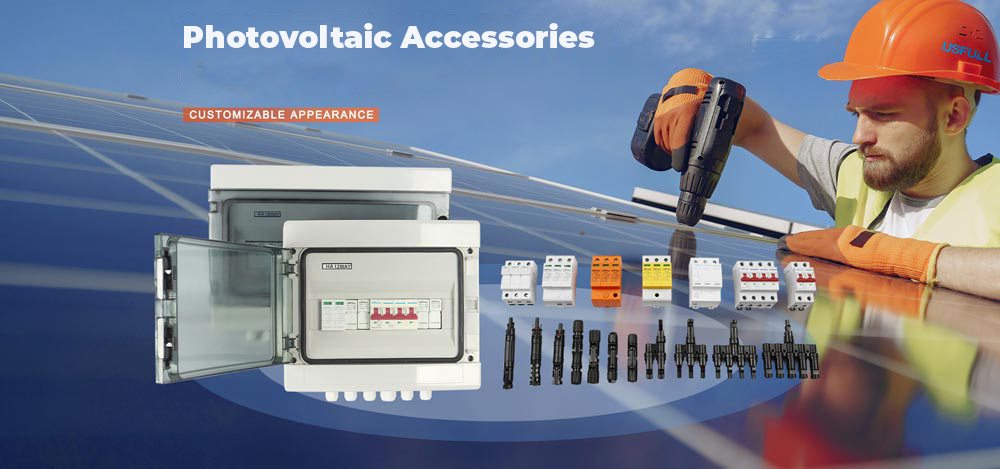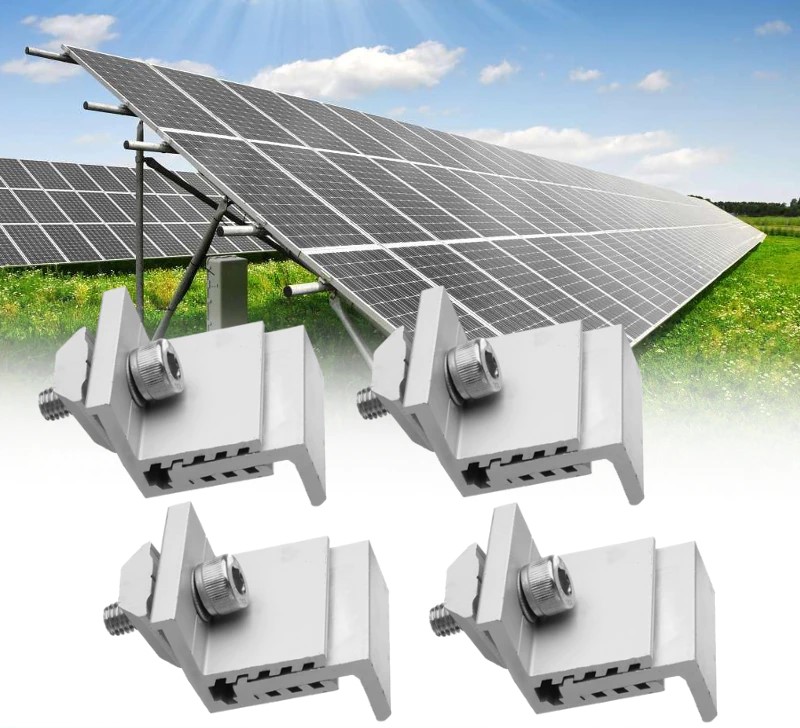People often get the wrong idea about Photovoltaic Accessories. We put them on our solar panel installations because they are useful. Could you explain how they help our homes and businesses get more energy from the sun’s rays?
This article will help you learn more about photovoltaic accessories and figure out what role they play in the whole system.
Scientists came up with photovoltaics as a way to get electricity from the sun. Solar panels are often used with other photovoltaic parts, such as batteries, inverters, and mounts.
A part of this system is photovoltaic accessories, which are the tools that the solar panel system needs to do all of its many tasks. The PV accessories from USFULL make your solar panel installation work better and faster. These tools make it possible to fight in harsh conditions like rain, snow, and strong sunlight.
Photovoltaic Accessories System:
Usually, photovoltaic accessories have the following parts:
1. Photovoltaic Conversion of Solar Energy:
A PV Combiner Box is the first piece of gear we’ll talk about. The Solar PV Combiner Box protects against too much current and too much voltage. This makes the inverter safer and more reliable.
It lets you connect solar strings in parallel and comes with the right safety features. The number of strings determines how many circuit breakers can be installed in the PV combiner box.
For instance, MNPV4 means that there are four strings and four circuit breakers.
For example, SMA 15 means that there are 15 strings and 15 breakers.
Features
- Strong water resistance, dust resistance, and corrosion resistance all make a solar PV combiner box much more reliable.
- IP65 is a higher level of protection because PV combiner boxes are often put outside.
- It features a superior die-cast aluminium shell.
- With the PV Combiner Box, many PV panels are connected in series to the distribution box.
- Plastic PV Combiner Boxes are easier to put together and may cost less to install.
Benefits
- You can always count on it to work right.
- It will also keep you safe from the power board and protect your investment.
- Improved resistance to lightning strikes; damp days no longer jeopardise solar panel integrity.
- It is easy to put together.
- It can be used in both business and home PV systems
2. Fuses
The FPRV-63 DC from USFULL If the current in a circuit is higher than what the fuse can handle, the fuse will melt and cut power to the rest of the circuit.
DC FPDV-30 The main job of fuses is to keep electrical circuits from getting too much current. If the fuse detects something dangerous, it will automatically blow and cut the power.
Any device that needs 32A of DC current can use the DC PV-32X fuse. A fuse stops the flow of electricity that could otherwise melt cables and parts or turn expensive equipment into vapour.
It has a UL94V-0 thermal plastic case that protects against arcing, heat, and too much current.
Features
- There are many ways to use a fuse.
- If you replace it every time it breaks, you won’t have to pay for a pricey “repair call.”
- A standard fuse might take longer to fix your thermal fuse than an FPRV-30 DC fuse.
- There isn’t another plug-and-play device on the market that is as easy to use and cheap.
- The PV panels are protected from damage caused by overloads and short circuits by a dc fuse that quickly blows when these things happen.
Benefits
- A DC fuse protects an electrical circuit from high currents that could start a fire. It also breaks the circuit if the current gets too high.
- This protection is very important for keeping your home and all of its electronics safe.
- With a DC fuse, your electrical system will work the way it was meant to, so you won’t have to worry about blowing fuses every time you leave a light on.
- Use a DC fuse to turn off the power to your electrical system so that no one gets shocked.
- It protects dc circuits and works well with solar panels, inverters-u pipe, and other electronic parts.
3. FLY1-PV SPD:
The FLY1-PV SPD is a PV standard surge protector that keeps lightning and thunder from damaging the PV system and inverter.
It is both technologically advanced and nice to look at. It is the last piece of the puzzle for a PV power plant.
Features
- DC An SPD is a type of device used in power grids to protect against overvoltage and overcurrent. It is put between the solar panel and the load.
- It can use the power of a lightning strike to do things.
- DIN RAIL mounting is part of SPD’s solar panel field. Also, It can be put on the wall and used to plug in wires.
- This series of surge protectors have a 25ns discharge time at rated peak current and may cut surge current by a lot.
Benefits
- DC Surge Suppression Devices can be used to protect photovoltaic and inverter systems from lightning (DC SPD).
- You can be sure that power surges and spikes won’t damage your expensive gear.
- With this useful addition, you may be able to save money, time, and work while making your PV system work better.
- It is a great choice for both indoor and outdoor use because it is easy to set up and poses few risks.
4. A direct current circuit breaker
A circuit breaker is an important safety device for a DC power system that keeps photovoltaic parts, equipment, and solar systems from getting too much current or short-circuiting.
When the breaker finds a problem, the electricity is turned off right away.
Features
- When the DC breaker is tripped, the status of the system is shown by a green light.
- The ARC system can pick up on any changes in the current that isn’t normal.
- The USFULL DC breaker has a case that can’t catch on fire.
- The DC breakers might reset on their own.
Benefits
- In the event of a short circuit, the DC breaker will be set off.
- Using the sign, it is possible to find the broken light fixture and have it fixed or replaced. In the long run, this ease of use will save you a lot of time.
- It keeps electric systems safe.
- The best way to stop injuries and property damage from DC arc faults are to use an ARC Extinguishing System.
5. MC4 Connector
Most PV systems use the MC4 Connector, which is a type of connector. When a solar panel is connected to an inverter, it needs an MC4 Connector so that it doesn’t need an anti-reverse mechanism.
The “MC” in “MC4” stands for a lot of contacts, and the “4” stands for a contact pin with a diameter of 4 mm.
Features
- When putting solar panels on an open roof, the MC4 Connector makes the connection more stable and safe.
- Connectors with stronger, self-locking pins are more stable and secure.
- Its PPO material is waterproof, long–lasting, and safe for the environment.
- Copper is used to connecting the MC4 solar panel cables because it is the best material for moving electricity.
Benefits
- The MC4 Connector can be recycled and is good for the environment.
- Losses can be cut by up to 70% with DC-AC conversion, which can save a lot of money.
- The copper core is so thick that it will last for years no matter how hot it gets or how much sun it gets.
- In photovoltaic applications, the self-locking stability of MC4 Connectors is very helpful when working with wires with a bigger diameter.
Conclusion:
If you use high-quality parts, it could help your PV system last longer. Moreover, USFULL’s photovoltaic accessories take up little space, are cheap, don’t need much extra equipment, and can be put in place in just a few minutes. Also, Use these parts to make sure that your PV system is working well.


